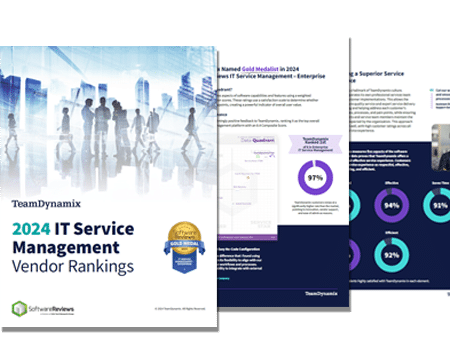
Companies Say They Need Automation, Easy-to-Manage ITSM
A study from Information Week and TeamDynamix shows companies are looking to invest in IT Service Management (ITSM) software that is simple to administer and

The Info-Tech ranking report offers a unique view of the market based entirely on in-depth customer interviews. Download the Info-Tech ITSM Quadrant and Customer Viewpoint report today.

We’ll show you some of our best situations and show you exactly how to execute them to get immediate results. The best part is, iPaaS tools often feature easy-to-use click and drag functionality, meaning you don’t need a dedicated employee building integrations and workflows.

System Integrators, Value Added Resellers, Technology Providers, and Buying Consortiums can benefit from a partnership with TeamDynamix.

The Info-Tech ranking report offers a unique view of the market based entirely on in-depth customer interviews. Download the Info-Tech ITSM Quadrant and Customer Viewpoint report to gain a better understanding of key vendor strengths and emerging market requirements.
It comes as no surprise that only 6 percent of IT leaders surveyed believe chatbots are effective and highly adopted for self-service. We’ve all had a bad chat experience when trying to use a traditional chatbot for customer service – the conversations are clunky, your intentions are often misunderstood and the success rate of the interaction is often extremely low.
Chatbots have long been touted as a valuable tool for IT Service Management (ITSM), offering a promising solution for handling common use cases and deflecting traffic from overwhelmed IT service desks.
IT leaders are often keen to implement chatbots to supplement ticketing inquiries, expedite response times and enhance end-user satisfaction, but the outcomes have been mixed. The concept is that these chatbots can simulate human conversations, replacing hands-on-keyboard technicians to deliver faster results for IT customers, from answering basic questions to directing them to the appropriate human resource for escalation or triggering automated fixes to their problems.
IT teams utilize traditional chatbots to improve self-service functionality, reduce ticket volumes and enhance delivery speeds. Nevertheless, most teams have yet to achieve the desired outcomes they had anticipated from their initial chatbot deployments.
Why is this the case?
Traditional chatbots operate by utilizing question/answer pairs based on knowledge base information and manually entered intent-based pairs. However, the conversation often deteriorates quickly because the chatbot misinterprets the utterance or question, and its ability to provide answers is limited to the knowledge base. And it’s this poor experience that results in unhappy customers.
According to a recent market study on chatbots and conversational AI from InformationWeek, 48 percent of respondents say their existing chat technology does not accurately solve issues or gets intent wrong, and 38 percent say it’s time-consuming to manage and doesn’t self-learn. This last point coincides with the fact that 29 percent of IT departments say they must manually load intent/answer pairs into the chat platform.
Additionally, respondents reported on the ways that chat tools break down, with the top answers being:
So, what’s the alternative?
Conversational AI is a broader term that refers to AI-driven natural language processing (NLP) that powers a range of automated communication vehicles like chatbots, virtual assistants and more advanced automated phone center applications.
Conversational AI platforms use data and NLP to recognize vocal and text inputs, mimic human interactions and facilitate conversational flow. The right conversational AI can potentially help lackluster chatbot deployments overcome their current challenges.
Because conversational AI chatbots understand intent, they are much more effective when it comes to assisting customers and end-users.
And while conversational AI is a much better alternative to traditional chatbots – not all conversational AI is equal. There are different ways that NLP AI can be “taught.” The difference in capability all comes down to what kind of language “brain” the self-learning AI model uses.
The reason why some chat technologies can get things so wrong all the time is that the brain they use is not quite fully developed. Many of the proprietary models used to create these NLP brains are working with insufficient training data and rudimentary models.
Because of this, it’s recommended that you don’t invest in a conversational AI tool that’s built around a small, proprietary NLP engine. Instead, find a tool that’s been built using a standardized NLP engine developed by the likes of Microsoft, Google, or Amazon Web Services.
Utilizing a conversational AI built with standardized NLP created by a major provider with strong AI science resources ensures chat interactions are intentional and meaningful. This under-the-hood capability gives IT teams a greater shot at higher success rates with their chat, which in turn means people will keep coming back to utilize the tool.
And the higher your adoption rate is the better your conversational AI experience can be. Because the more a self-learning conversational chat channel is used (one with a good NLP brain, that is), the more intelligent it can be—meaning the experience continues to get better and evolve.
According to the survey, there are four key elements for a successful chat experience when it comes to using conversational AI for self-service. The top cited element was a strong knowledge base for content to feed the chat, which was named by 75 percent of respondents. That was closely followed by the ability to personalize the conversation with details about the customer, named by 63 percent. Third and fourth place were ranked equally, named by 62 percent, who equally weighted the ability to present questions to the employee that drives dynamic content with the ability to automate the fulfillment of requests from the chat interaction.
Conversational AI especially benefits service management teams when paired with enterprise integration and automation. This combination can elevate chat from a glorified knowledge base search engine into an automated, action-centered channel to field requests.
No matter how good the knowledge base, personalized user information can only be uncovered through the inherent ability to connect to business systems via APIs and integrations. This capability is what makes it possible to automatically provide dynamic content and fulfill simple, repetitive requests for action.
One example of this in action would be an employee asking the chatbot how much paid time off (PTO) they have left for the year. A first-generation chatbot may not be able to answer that, instead offering a link to the employee knowledge base article about how much PTO each employee gets annually.
A conversational AI chatbot tied to a well-connected integration and automation layer could personalize the response leveraging Single Sign-On, and then access the employee’s data from another application to deliver an accurate, fast response. In this case, the response may say, “Currently, you have 12 days of PTO left this year.” It might even follow up with a question like, “Do you want to know how many of these days will roll over next year?” or, “Would you like to request time off?” If the end-user response is to request time off, the solution would present a form for the request to be entered and then pass that data back to the PTO tracking platform.
Want to learn more about chat vs. conversational AI? Read the full market study: State of Chatbots and Conversational AI.

A study from Information Week and TeamDynamix shows companies are looking to invest in IT Service Management (ITSM) software that is simple to administer and

When it comes to improving IT Service Management (ITSM) maturity, many organizations turn to ITIL – a framework that guides users through a process-based approach

Enterprise Service Management (ESM) is the practice of extending IT Service Management (ITSM) principles beyond the IT department to other areas of an organization. ESM
TeamDynamix’s award-winning SaaS cloud solution offers IT Service and Project Management together on one platform with enterprise integration and automation.
[email protected]
(877) 752-6196
Contact Us
